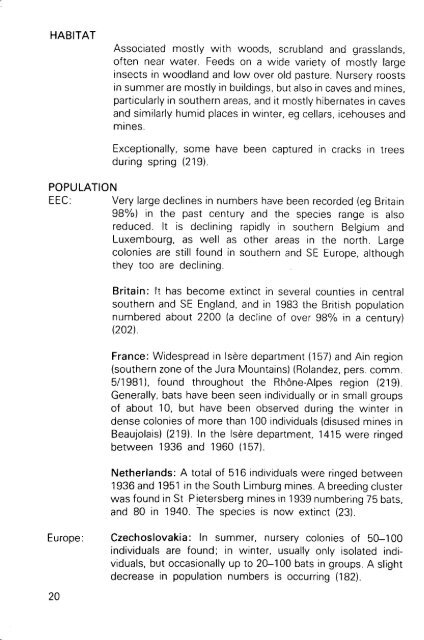kf 7 - NERC Open Research Archive - Natural Environment Research
kf 7 - NERC Open Research Archive - Natural Environment Research
kf 7 - NERC Open Research Archive - Natural Environment Research
Create successful ePaper yourself
Turn your PDF publications into a flip-book with our unique Google optimized e-Paper software.
HABITAT<br />
20<br />
Associated mostly with woods, scrubland and grasslands,<br />
often near water. Feeds on a wide variety of mostly large<br />
insects in woodland and low over old pasture. Nursery roosts<br />
in summer are mostly in buildings, but also in caves and mines,<br />
particularly in southern areas, and it mostly hibernates in caves<br />
and similarly humid places in winter, eg cellars, icehouses and<br />
mines.<br />
Exceptionally, some have been captured in cracks in trees<br />
during spring (219).<br />
POPULATION<br />
EEC: Very large declines in numbers have been recorded (eg Britain<br />
98%) in the past century and the species range is also<br />
reduced. It is declining rapidly in southern Belgium and<br />
Luxembourg, as well as other areas in the north. Large<br />
colonies are still found in southern and SE Europe, although<br />
they too are declining.<br />
Britain: It has become extinct in several counties in central<br />
southern and SE England, and in 1983 the British population<br />
numbered about 2200 (a decline of over 98% in a century)<br />
(202).<br />
France: Widespread in Isbre department (157) and Ain region<br />
(southern zone of the Jura Mountains) (Rolandez, pers. comm.<br />
5/1981), found throughout the Rhône-Alpes region (219).<br />
Generally, bats have been seen individually or in small groups<br />
of about 10, but have been observed during the winter in<br />
dense colonies of more than 100 individuals (disused mines in<br />
Beaujolais) (219). In the Isère department, 1415 were ringed<br />
between 1936 and 1960 (157).<br />
Netherlands: A total of 516 individuals were ringed between<br />
1936 and 1951 in the South Limburg mines. A breeding cluster<br />
was found in St Pietersberg mines in 1939 numbering 75 bats,<br />
and 80 in 1940. The species is now extinct (23).<br />
Europe: Czechoslovakia: In summer, nursery colonies of 50-100<br />
individuals are found; in winter, usually only isolated individuals,<br />
but occasionally up to 20-100 bats in groups. A slight<br />
decrease in population numbers is occurring (182).

















